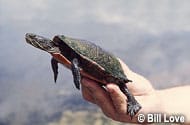Description:
Captive Housing: Western painted turtles stay at a fairly manageable size and can be kept indoors and out. For indoors, hatchlings can easily be housed in a 10-gallon tank. Start with two basking sites, one on either end of the tank. Fill the tank with water near level with the basking sites, which can be bricks, flat rocks, floating logs, cork or any number of commercially constructed turtle basking sites. Over one basking site, hang a heat lamp. Use whatever wattage/distance it takes to create a 85- to 90-degree basking site. Leave the basking site on the other side of the tank unheated. Over the entire tank, run a florescent UVB tube. Set both lights up on a 12-hour on/off cycle. Water quality is important, so get a high-quality filter. Clean the cartridges weekly, and replace them completely as needed. You can ad gravel or pebbles to the tank to make it look prettier, but it just adds to the cleaning chore and is not needed for the turtle. Completely empty and clean the cage at least once a month, or more, depending on the quality of your filter. If the tank gets dirty or the water gets fouled, clean it. As your babies grow, or if you acquire larger turtles to start with, a larger tank will be needed. The more room, the better. A 6-inch male will need about a 40-gallon breeder tank to thrive. You can also keep painted turtles outdoors in just about any place in North America. Provide a roomy pond, stock tank or Waterland Tub with a filter and areas of shade. Or build a real pond, with a liner and the whole nine yards. Make sure to provide haul-out areas for basking, and if using a pond, make sure to provide a barrier to keep the turtles from wondering off (or predators from getting in). If you plan on keeping them out year-round, they will need to hibernate. To do this, you need to provide a layer of soft mud or silt about 8 inches deep in the water. If you can’t do this (cleaning is a real chore), bring them indoors for the winter. You can set them up just as described for an indoor setup, or you can place them in a plastic container with shredded newspaper and put them in the garage or a cold part of the house. Check on them weekly to make sure they are doing well. If there is a question, set them back up and keep them up all winter. Diet: They will eat a wide variety of food, including crayfish, live or dead fish, or fish parts, night crawlers, various greens, such as collards and romaine lettuce, pelleted turtle diet and even pinky mice. Feed them at least three times a week, and only feed them what they will consume in one sitting. Remove all uneaten food to keep the water quality up. What’s Available: Commonly captive bred. Locating them is not a problem. They are sold at reptile shows, pet stores and over the Internet. There are morphs. Albino Western painted turtles are out there. They are somewhat pricey, but very lovely. There are also hypomelenistic morphs that are also very pretty. Morphs are not always easy to locate, but they can sometimes be found at reptile shows, breeders found on the Internet, and in pet stores specializing in herps. Ken Foose produced his first captive-bred snakes at age 11. With a Master’s Degree in zoology, he has been both a zookeeper and curator. He opened Exotic Pets, which specializes in reptiles and amphibians, in Las Vegas in 1991. He is currently president of the International Herpetological Symposium.
Habitat:
The western painted turtle is rather adaptable and is known to occur in prairie pothole wetlands as well as river floodplains and oxbows.
Range:
The western painted turtle is found in the mid-western states of Oklahoma northward to the Dakotas and extends as far as Saskatchewan, Canada. It reaches the eastern portion of its range in upper Michigan and Ontario where it intergrades with other races of painted turtles. It is found in the Rio Grande of New Mexico. It does occur on the west coast in Washington and British Columbia, although its arrival there may represent recent introductions.
Scientific Name: Chrysemys picta bellii
Species Group: turtle
Family: Emydidae
Size: The western painted turtle is the largest of the four subspecies and attains a carapace length of up to 7 inches.
Level: beginner
Weight: N/A
Dangerous: No



